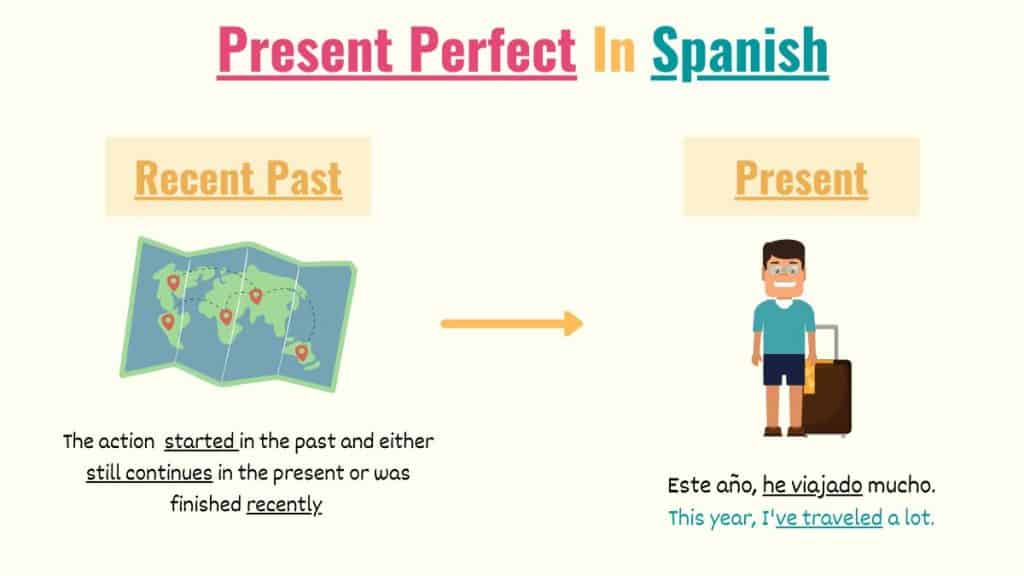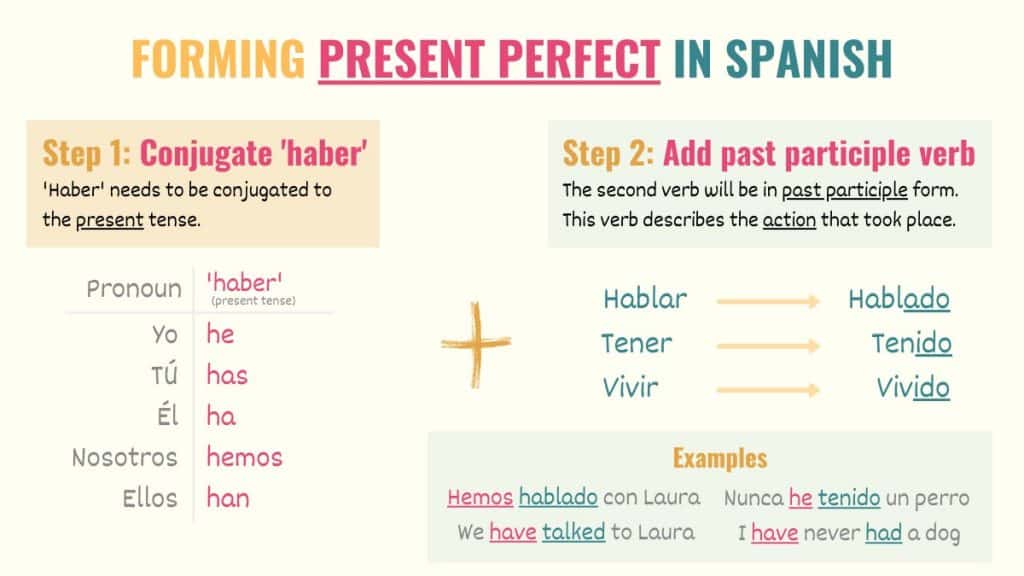


El presente perfecto is a basic tense that you need to know if you’re learning past tenses in Spanish. But since our language has more than one past tense, I find that a lot of people want to know what the present perfect tense is in Spanish. Present perfect in Spanish is a past tense that is used to talk about past actions that happened in a moment close to the moment of speaking or that still have repercussions in the present. Spanish present perfect is built with the present form of ‘haber’ and past participle verbs.‘Presente perfecto’ is an important tense that you want to get familiar with. However, when you have more than one past tense to choose from, things can get a bit confusing. Like Dumbledore said ‘mysterious thing, time. Powerful, and when meddled with, dangerous’. Jokes aside, in this guide, I’ll teach you:
Of course, I’ll also include some real-life examples so you see how this tense works. By the end of this, ‘presente perfecto’ will no longer be a problem for you.
Spanish present perfect is formed with the verb haber conjugated to the present form and a past participle verb.

When trying to conjugate to compound tenses in Spanish, many learners get confused because ‘tener’ is the direct translation of ‘to have’. But we actually use ‘haber’ instead, which also translates as ‘to have’. With the present perfect tense, we always conjugate ‘haber’ to the present tense.
When forming the present perfect in Spanish, ‘haber’ helps you indicate who is the subject that is performing the action. The second part of the structure (the verb in participle form) will allow you to describe what action was performed.
As a quick reminder, regular Spanish past participles are created by adding the following endings to the stem of the verb (the word that is left after deleting -AR, -ER or -IR).
Here is the structure for presente perfecto as well as some examples of how to use it:
[Haber conjugated to the present tense] + [verb in past participle] + [complement]
Julieta, ¿ya has visto esta película?
Julieta, have you seen this movie?
Creo que nunca hemos probado los chilaquiles.
I think we have never tried chilaquiles.
Ya te he dicho que no puedo ir.
I have told you that I can’t go.
Bill y Doug han descompuesto tu teléfono.
Bill and Doug broke your phone.
Take Note: In Spanish, perfect tenses are conjugated by using the ‘haber + past participle’ formula. In this case, you get to conjugate ‘haber’ to any tense that you need. So for instance, if you conjugate ‘haber’ to the imperfect tense, you’ll create the Spanish past perfect tense 😉
When conjugating reflexive verbs to the present perfect tense, the reflexive pronoun will always be placed before ‘haber’. This is the formula that you can use for this cases:
[Reflexive pronoun] + [‘haber’ present tense] + [verb in past participle]
Celia no se ha bañado hoy.
Celia hasn’t showered today.
¿A qué hora te has despertado?
What time did you wake up?
Todavía no me he peinado.
I haven’t combed my hair.
As you can see from the examples above, even though Spanish reflexive verbs work with pronouns, there are no words between the verb ‘haber’ and the past participle. This rule is also applied when your sentence needs direct or indirect object pronouns:
[Object pronoun] + [‘haber’ present tense] + [complement]
¿ Le has dado las flores a María?
Did you give Maria the flowers?
Ya hemos venido aquí y no está tan padre.
We have been before and it’s not that cool.
Karina no me ha dicho nada, ¿qué pasó?
Karina hasn’t said anything to me , what happened?
Spanish present perfect can be used to talk about:
| Use | Latin American Spanish | Castilian Spanish |
| Actions that have been finished recently | NO (affirmative sentences) | YES |
| Life experiences | YES | YES |
| Past actions that have not finished | YES | YES |
| Past actions without a clear starting point | YES | YES |
Just so you get a better understanding of what this means, here are some examples:
No he terminado mi tarea.
I haven’t finished my homework yet.
¿Qué has desayudado esta mañana ?
What did you have for breakfast this morning ?
Hoy no hemos visto a Leo, ¿sabes si vino?
Today , we haven’t seen Leo, do you know if he is here?
Just like other tenses, present perfect in Spanish is triggered by certain time markers . In humans words, ‘presente perfecto’ usually works with the following vocabulary:
Notice that the words ‘mañana’ and ‘año’ can be replaced for other nouns that help you measure time, such as ‘ayer’, ‘semana’, etc. In the following sections, I’ll explain to you more in-depth the different uses of Spanish present perfect.
One of the most common uses of Spanish present perfect is to describe actions or events that were completed recently. By this, I mean that the finished action is very close to the present . In this case, speakers typically use time markets to indicate that proximity to the present.
Here are some examples that can help you understand this theory better. Notice that time markers can be placed either at the beginning or end of the sentence.
(Time marker) + (present perfect) + [complement]
¿Cómo te has sentido esta mañana ?
How have you been feeling this morning ?
Diego no ha venido a trabajar esta semana .
Diego hasn’t come to work this week .
Esta mañana , Dalia y yo hemos desayunado juntas.
This morning , Dalia and I had breakfast together.
He hablado con tu director y dice que necesitas estudiar.
I spoke to your principal and he says you need to study.
This use of present perfect in Spanish is commonly taught in all Spanish courses. But there’s a BIG EXCEPTION that you need to keep in mind. You see, this use is super common in Castilian Spanish, but not in Latin America.
For this context, we Latin American Spanish speakers would use preterito in affirmative sentences because, although it was recently completed, the action is already over. So, in fact, in Latin America, the applications of present perfect are exactly the same as in English.
Castilian Spanish
Te he enviado los papeles está mañana.
I sent you the papers this morning.
Hoy he tenido que ir a una reunión con Paco.
Today I had a meeting with Paco.
Latin American Spanish
Te envié los papeles está mañana.
I sent you the papers this morning.
Hoy tuve que ir a una reunión con Paco.
Today I had a meeting with Paco.
If you’re very familiar with Spanish, leaving the accent aside, you can identify Castilian speakers based on the way they use presente perfecto ;).
Just like in English, in Spanish, we also use the present perfect to talk about our life experiences. Think of it this way: this use is very similar to the game have you ever…? In this case, the present perfect allows us to express that our chance to have a new or the same experience is not over.
Although it’s not a rule of thumb, typically, sentences with this meaning use adverbs of time (such as siempre, nunca and jamás) or adverbs of quantity to indicate when and how many times have you done something.
Here are some examples of how to use the Spanish present perfect to talk about life experiences.
(Adverb of time) + [present perfect] + [complement]
Nunca he probado la paella.
I have never tried paella.
¿ Alguna vez has ido a algún concierto?
Have you ever been to a concert?
Simpre hemos querido aprender español.
We’ve always wanted to learn Spanish.
Here is the phrase structure that you can use if you want to express how many times you’ve done something.
[Present perfect] + [complement] + (adjective of quantity)
Zulema ha estado en Italia tres veces .
Zulema has been to Italy three times .
¿ Cuántas veces has visto esa película?
How many times have you seen that movie?
Te he dicho un montón de veces que no puedo ir.
I have told you many times that I can’t go.
Take Note: Notice that, unlike English, adverbs, pronouns, or adjectives cannot be placed in the middle of the structure haber + participle. To put it simply, the two verbs (‘haber’ and the participle) cannot be split.
In both Latin American and Castilian Spanish, presente perfecto is also used to talk about past actions that are still developing or have certain repercussions in the present. In simple human words, these are actions that started in the past but have not finished.
Let’s see some examples so this is easier to understand:
[Present perfect] + [complement]
Todavía no he hablado con Sean.
I haven’t talked to Sean yet.
Esta semana, he leído dos libros.
This week, I’ve read two books.
No he tenido tiempo de limpiar.
I haven’t had time to clean.
La mamá de Maureen ha estado viviendo en Egipto por dos años.
Maureen’s mom has been living in Egypt for two years.
Just for the purpose of making it easier, check example #4. Our sentence implies that the action (Maureen’s mom living in Egypt) started at some point in the past (two years ago), but it’s not over. In fact, at the moment of speaking, she’s still living there.
The same principle applies to the other examples. So far I haven’t talked to Sean, but by using Spanish present perfect, I’m saying that I still have time to do it!
Another common use of the present perfect in Spanish is to talk about actions that were done in an unspecified period of time between past and present. In this case, explaining when something happened is less important than actually sharing the information.
But we can assume that the action took place close to the present. This use of the present perfect can be applied when talking about news, recent events or simply sharing some information with another person. Here are some examples:
[Present perfect] + [complement]
La verdad, has sido muy paciente conmigo.
To be honest, you have been very patient with me.
Últimamente has estado muy ocupado.
Lately, you have been very busy.
Se ha encontrado más evidencia.
More evidence has been found.
¿Han sabido algo de Mary?
Have you heard anything about Mary?
In Spanish, the difference between ‘preterite’ and ‘present perfect’ is that preterite is used to talk about actions that were finished at a specific time in the past . Present perfect refers to recent past actions and it emphasizes the fact that they are still happening now or are relevant to the present.
Many students struggle to understand when they’re supposed to use Spanish present perfect or preterite. As we have explained before, presente perfecto focuses on recent actions that have some repercussions or that are still going on in the present.
On the other hand, Spanish preterite is used to talk about actions that were completed at some point in the past. This means that the action is over and it’s not continuing in the present. Check these examples, so you see the difference yourself.
Present perfect
Este año he ido a China, Japón y Turquía.
This year, I’ve gone to China, Japan and Turkey.
Hoy he desayunado con mis amigas.
Today, I had breakfast with my friends.
Preterite
El año pasado fui a China, Japón and Turkey.
This year, I went to China, Japan and Turkey.
Hoy desayuné con mis amigas.
Today, I had breakfast with my friends.
Check examples #1 for both preterite and present perfect. By using presente perfecto we’re implying that the year is not over and, as a result, I can still travel to other places. However, with preterite, for some reason or another, the action is over. Meaning, that this year I can’t travel anymore.
Now, check the second set of examples. As mentioned before, Castilian speakers use present perfect when referring to actions that were recently completed . But, in Latin America, we use preterite for this type of sentence because that breakfast with my friends is over.
When it comes to learning to conjugate in the past in Spanish, there’s no doubt that you’ll need to learn presente perfecto. As a native speaker, I think that this is an easy tense to learn. As a teacher, I know that it can be challenging for Spanish learners. For that reason, in this guide, we have learned how to conjugate and how to use this tense.
Here are some key points that you need to keep in mind about the present perfect in Spanish:
Hopefully, has aprendido everything you need to know about this tense! Now, you’re ready to start implementing it in your sentences. To start, you could take this Spanish present perfect quiz. ¡Buena suerte!
Related Resources: